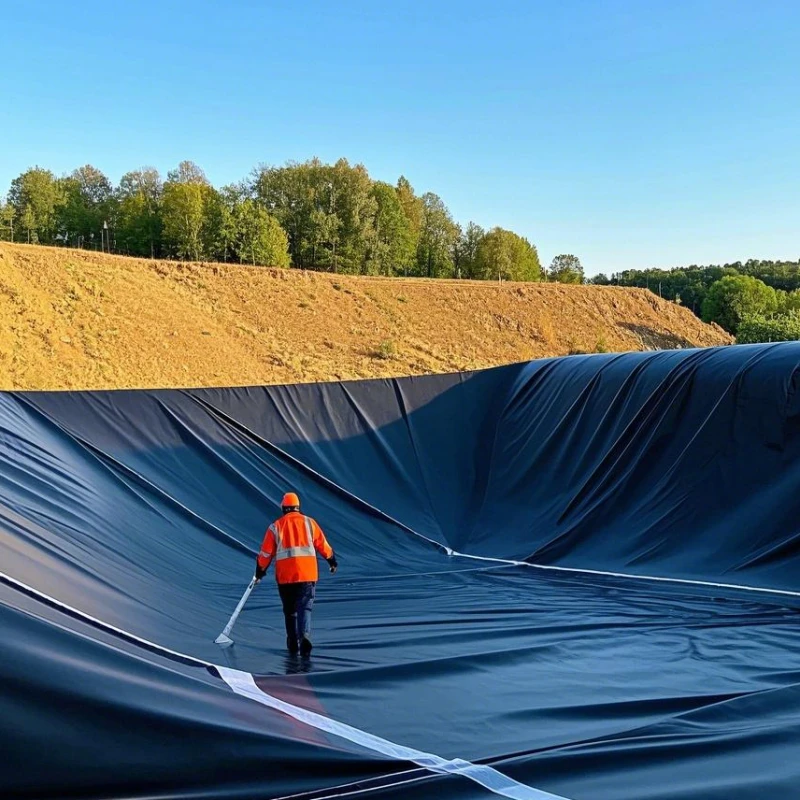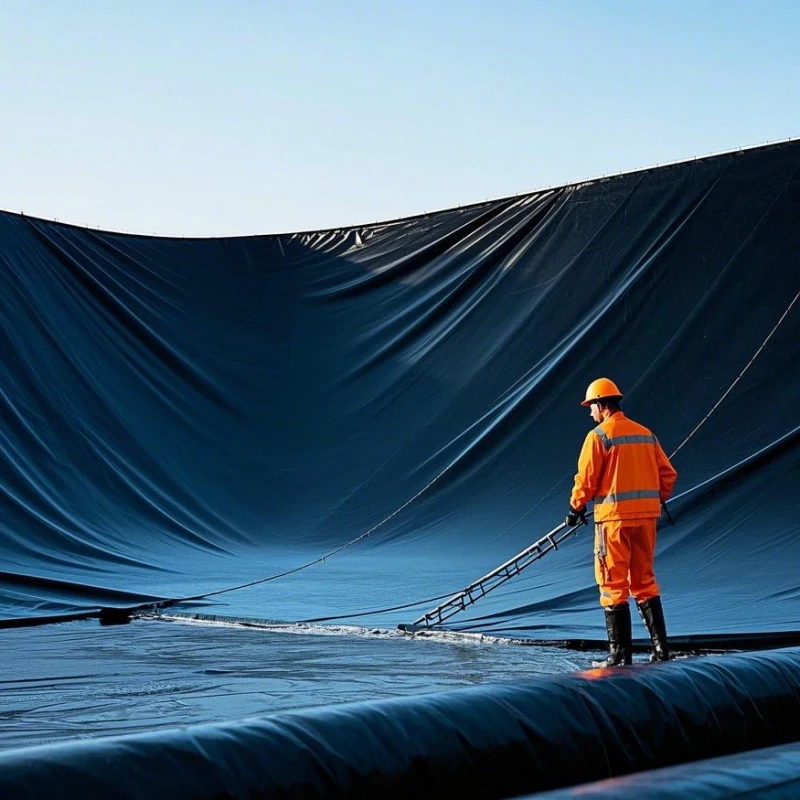What is a Geomembrane Liner?
In the realm of environmental protection and engineering, geomembrane liners stand as a vital component for effective containment solutions. These synthetic membranes, characterized by their impermeable nature, are widely used in industries like waste management, mining, water conservation, and more. Their role in safeguarding the environment from contamination and resource loss makes them indispensable.
This article delves into what geomembrane liners are, their types, applications, benefits, installation, and key considerations. Along the way, we will reference specific research data and industry insights for a well-rounded understanding.
What is a Geomembrane Liner?
A geomembrane liner is a synthetic sheet made from polymers designed to prevent the migration of fluids, gases, or contaminants. Its impermeable nature makes it an essential component in projects that require secure containment, whether for hazardous waste, water reservoirs, or industrial operations.
Types of Geomembrane Liners
Geomembrane liners are categorized based on their material composition, manufacturing process, and specific properties. Each type is designed to address distinct requirements, making them suitable for diverse applications.
1. High-Density Polyethylene (HDPE) Geomembranes
HDPE is one of the most commonly used geomembrane materials due to its exceptional durability and chemical resistance.
Characteristics:
High tensile strength.
Excellent chemical resistance to acids, alkalis, and hydrocarbons.
UV-resistant for outdoor applications.
Advantages:
Cost-effective for large-scale projects.
Suitable for both hazardous and non-hazardous waste containment.
Long lifespan (20-30 years).
Limitations:
Less flexible than other geomembrane materials.
May require specialized equipment for installation due to rigidity.
Applications:
Landfills, mining operations, secondary containment systems, and canal linings.

2. Linear Low-Density Polyethylene (LLDPE) Geomembranes
LLDPE combines flexibility and durability, making it an excellent choice for applications requiring adaptability to uneven surfaces.
Characteristics:
Enhanced flexibility compared to HDPE.
Moderate chemical resistance.
Lower tensile strength compared to HDPE.
Advantages:
Easily conforms to irregular surfaces.
Cost-effective for medium-scale projects.
Easier to weld during installation.
Limitations:
Slightly lower UV resistance compared to HDPE.
Applications:
Aquaculture ponds, landfill caps, and agricultural irrigation projects.
3. Polyvinyl Chloride (PVC) Geomembranes
PVC geomembranes are known for their flexibility and lightweight nature, making them ideal for temporary or short-term projects.
Characteristics:
High flexibility and elongation properties.
Good puncture resistance.
Susceptible to UV degradation unless stabilized.
Advantages:
Easy to install and handle.
Works well in areas with significant surface irregularities.
Suitable for temporary containment projects.
Limitations:
Not ideal for long-term exposure to sunlight.
Lower chemical resistance compared to HDPE.
Applications:
Canal linings, decorative ponds, and temporary waste containment.
4. Ethylene Propylene Diene Monomer (EPDM) Geomembranes
EPDM liners are synthetic rubber membranes renowned for their elasticity and weather resistance.
Characteristics:
Extremely flexible and stretchable.
Excellent UV and ozone resistance.
Long lifespan, often exceeding 30 years.
Advantages:
Ideal for large and irregularly shaped containment areas.
Resistant to extreme weather conditions.
Easy to repair and maintain.
Limitations:
Higher material cost compared to other liners.
Not suitable for applications with high chemical exposure.
Applications:
Water reservoirs, fish ponds, and decorative landscaping features.
5. Chlorosulfonated Polyethylene (CSPE) Geomembranes
CSPE liners, also known as Hypalon, are engineered for extreme durability in harsh environments.
Characteristics:
High resistance to UV radiation, chemicals, and heat.
Exceptional tensile strength and elongation.
Long lifespan with minimal maintenance.
Advantages:
Performs well under extreme temperature variations.
Resilient against prolonged exposure to chemicals.
Highly durable for long-term applications.
Limitations:
Higher cost compared to other materials.
Applications:
Floating covers for reservoirs, secondary containment systems, and industrial applications.
6. Reinforced Geomembranes
Reinforced geomembranes combine the impermeability of polymer sheets with the strength of a fabric reinforcement layer.
Characteristics:
Typically made with HDPE or PVC laminated over a geotextile.
Enhanced puncture and tear resistance.
Increased dimensional stability.
Advantages:
Excellent for high-pressure applications.
Can withstand mechanical stresses and heavy loads.
Durable and long-lasting.
Limitations:
More complex and expensive to produce.
Applications:
Landfill covers, high-stress containment areas, and heavy-duty industrial projects.
7. Bituminous Geomembranes
Bituminous geomembranes are composite liners made with asphalt layers for enhanced impermeability.
Characteristics:
Excellent resistance to chemicals and UV exposure.
Provides additional waterproofing benefits.
Performs well in cold climates.
Advantages:
Superior adhesion to various substrates.
Resistant to mechanical punctures.
Long-lasting with minimal maintenance.
Limitations:
Heavier than other geomembranes.
Requires specialized installation processes.
Applications:
Dam waterproofing, tunnel linings, and industrial containment.
8. Geosynthetic Clay Liners (GCLs)
Although not traditional geomembranes, GCLs are often combined with geomembrane liners for added protection. They consist of a layer of bentonite clay sandwiched between geotextiles or geomembranes.
Characteristics:
Provides a natural barrier against fluid migration.
High self-healing capabilities when punctured.
Advantages:
Combines natural and synthetic properties for robust containment.
Lightweight and easy to transport.
Limitations:
Requires hydration to perform effectively.
Applications:
Secondary liners in landfills, water reservoirs, and mining operations.
929182.webp)
Applications of Geomembrane Liners
1. Waste Containment
Landfills are among the most significant applications of geomembrane liners. According to a 2022 EPA report, over 85% of landfills in the U.S. use HDPE liners to prevent leachate from contaminating groundwater.
2. Mining Operations
In mining, geomembrane liners are used in heap leaching processes to contain chemicals used for ore extraction. Studies show that using HDPE liners can enhance ore recovery rates by up to 30%.
3. Aquaculture
Aquaculture farms use geomembrane liners for pond construction to reduce water loss and contamination risks. Research reveals that farms using LDPE liners experience 30% lower water losses than those using traditional clay ponds.
4. Water Reservoirs
Geomembrane liners play a critical role in water conservation. A study from 2023 highlighted that reservoirs with EPDM geomembranes save up to 40% of water annually compared to unlined reservoirs.
Advantages of Geomembrane Liners
1. Durability
Geomembrane liners, particularly those made of HDPE or EPDM, offer a lifespan exceeding 20 years under optimal conditions, making them a long-term solution.
2. Chemical Resistance
Their ability to withstand exposure to hazardous chemicals makes them ideal for industrial and waste containment applications.
3. Environmental Safety
Geomembranes prevent soil and water contamination, contributing to sustainable practices in industries like agriculture, mining, and waste management.
4. Cost Efficiency
While the initial installation costs can be significant, geomembranes reduce long-term maintenance and environmental liability expenses.
Research Data
Here is a summary of geomembrane liner performance across different parameters.
Comparison of Geomembrane Materials
| Material | Tensile Strength (MPa) | Flexibility Rating | UV Resistance | Cost Efficiency |
|---|---|---|---|---|
| HDPE | 20-30 | Low | High | High |
| LDPE | 10-20 | High | Medium | Medium |
| PVC | 15-25 | High | Low | Medium |
| EPDM | 5-10 | Very High | High | Low |
Performance in Applications
| Application | Recommended Material | Expected Lifespan (Years) | Cost (USD/m²) |
|---|---|---|---|
| Landfill Linings | HDPE | 25-30 | 1.5-2.5 |
| Mining Containment | HDPE | 20-25 | 2.0-3.0 |
| Aquaculture Ponds | LDPE | 15-20 | 2.0-3.0 |
| Water Reservoirs | EPDM | 30+ | 3.0-4.0 |
Key Considerations for Choosing a Geomembrane Liner
Application Needs: Different applications require specific materials based on chemical exposure, pressure, and environmental conditions.
Environmental Factors: Consider UV exposure, weather extremes, and soil type.
Installation Costs: Factor in both the cost of the material and the labor required for installation.
Lifespan and Maintenance: Opt for a liner with minimal maintenance needs and a long operational life.
Installation Process
The installation of geomembrane liners requires expertise and precision to ensure maximum efficiency.
Surface Preparation: Clear the site of debris and level the surface.
Placement: Unroll and align the geomembrane sheets carefully.
Seaming: Use heat welding or adhesives to seal the joints, ensuring no leaks.
Inspection: Conduct a thorough integrity test to detect leaks or imperfections.
Environmental Benefits
Geomembrane liners significantly contribute to environmental sustainability. For instance:
Water Conservation: Reservoirs lined with geomembranes report a 90% reduction in water loss due to seepage.
Soil Protection: Case studies from California have demonstrated a 95% decrease in soil contamination in industrial waste containment projects using HDPE liners.
Future Trends in Geomembrane Liners
The future of geomembrane liners lies in the development of:
Bio-Based Geomembranes: Using renewable materials for eco-friendly applications.
Smart Liners: Incorporating sensors to monitor leaks or environmental changes.
Improved Durability: Advancements in polymer technology promise even longer lifespans.
Conclusion
Geomembrane liners are a cornerstone of modern containment solutions, offering unparalleled durability, chemical resistance, and environmental safety. Whether for landfill lining, mining operations, or water conservation, their applications are vast and critical to sustainable development.
As industries continue to prioritize environmental protection, geomembrane liners will remain a key player in shaping a safer and more sustainable future.
Why Choose Haoyang Environmental Co., Ltd.?
Founded in 2008, Haoyang Environmental Co., Ltd. is a leading provider of high-quality geomembrane liners and geosynthetic materials. We specialize in environmental engineering, offering innovative solutions for soil remediation, waste treatment, and containment projects worldwide.
Why Partner with Us?
Certified Quality: ISO 9001, ISO 14001, OHSAS 18001, and CQC certifications.
Innovation: 3 invention patents and 32 utility model patents.
Expertise: A professional R&D team focused on sustainable and effective solutions.
Our products and services ensure long-lasting, reliable containment for various industries. Contact us today for your geomembrane and environmental material needs.

897.webp)
942.webp)
237.webp)